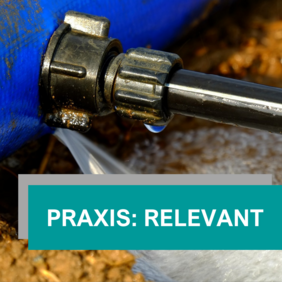Experts at TZW have been working on the topics of water consumption and digitalisation for years. One aspect is analysing large amounts of data with the aim of gaining new insights and thus creating added value. Together with Wasserwerke Zwickau, TZW is working on the topic of digital water loss monitoring, which also utilises machine learning methods.
DVGW Code of Practice W 392 describes how water losses can be determined, how a water balance can be drawn up and how key figures and monitoring can be carried out. Wasserwerke Zwickau GmbH carried out a water balance for 2017 in accordance with these specifications. This includes the determination of feed-in and output (total billed output and unbilled output) of the drinking water distribution network. The unbilled grid feed is caused, among other things, by extinguishing water, tank and pipe emptying as well as hydrant and pipe flushing. The difference can be used to determine the total water loss, which is differentiated into a real and an apparent share. This method was used by the water supply company to identify and rectify leaks.Despite the successful application of the method, the total water loss could not be adequately explained. The difference between feed-in and sales is difficult to account for in part due to the following points:
- Consumption anomalies
- Measuring equipment inaccuracies
- Non-detectable leaks
For this reason, a project was set up in collaboration with TZW in a small rural town with around 1,600 inhabitants. In addition to single and multi-family homes, the area is characterised by commerce, a food market, a retirement home and agriculture. The area is divided into two zones whose feed-in is measured with a time resolution of 30 seconds. The aim of the work was to characterise consumption more precisely by means of a detailed evaluation of the consumption time series.
The method developed by TZW for analysing consumption time series enables both comprehensive characterisation and the identification of anomalies, e.g. water losses. The method initially allows the characterisation of normal behaviour by differentiating between various demand profiles, such as working days or weekends. In addition, deviations from normal consumption are recorded as anomalies, whereby a distinction can be made between four different types of anomalies. Compared to established methods such as night-time minimum consumption measurement, a more detailed analysis of consumption time series is possible. This analysis method is an essential component for monitoring water losses.
The text is an extract from an article that appeared in DVGW energie wasser praxis 12/2023. You can read the full text in German here (pdf-file).
In the PRAXIS: RELEVANT series, TZW presents examples of successful projects that have been implemented together with water supply companies.

![[Translate to English:] Prüfstelle-Produktprüfung_Teststand Test centre and product testing](/fileadmin/_processed_/0/9/csm_TZW-Karlsruhe_Pruefung_Geraete-Teststand_377188946c.jpg)
























